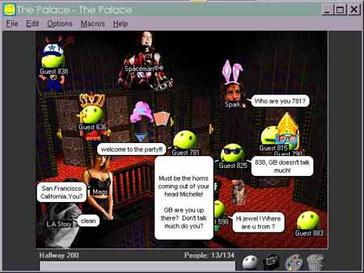The Palace (computer program)
 |
|
| Developer(s) | Time Warner Interactive, independent developers |
|---|---|
| Operating system | Mac OS 9, Mac OS X, Linux, and Microsoft Windows |
| Type | Virtual Community, client |
| License | Proprietary |
| Website | www |
The Palace (or Palace Chat, Chat Palace, Palace) is a computer program to access graphical chat room servers, called palaces, in which users may interact with one another using graphical avatars overlaid on a graphical backdrop. The software concept was originally created by Jim Bumgardner, and produced by Time Warner Interactive, in 1994, and was first opened to the public in November 1995.
While there is no longer any official support for the original program, a new client has been developed and is actively maintained by Jameson Heesen. Many chat servers are still operating and can be found on the The Palace Portal Live Directory. Palace clients and servers are available for Mac OS 9, Mac OS X, Linux, and Microsoft Windows.
The Palace has a flexible avatar system that allows users to combine small, partially transparent images to create a unique look for themselves. Once the member has created an avatar to represent herself or himself, the member can pick up various pieces of clothing or other items, such as hats, handbags, cans of soda, candy bars, bicycles, or hand tools. The Dollz that can be seen in many places around the Internet today originated in The Palace.
By default, users are represented by spherical smiley face emoticons, but can also wear bitmaps called props. User messages appear as chat bubbles above their avatar, similar to those seen in comic books, and stored in a chat log. Each room in a palace is represented by a large image that serves as a backdrop for the users. By clicking on certain areas in a room called doors, users can travel either to different rooms in the same palace, another palace server, or even an address leading to a different service, such as Web sites and e-mail. In some rooms, users are allowed to paint on the backdrop using a simple suite of drawing tools similar to oekaki.
...
Wikipedia
